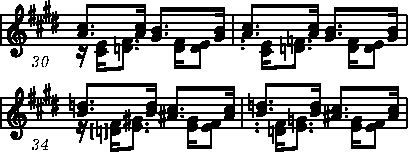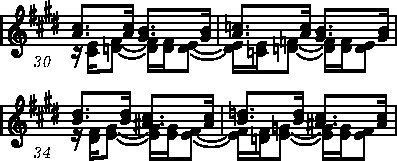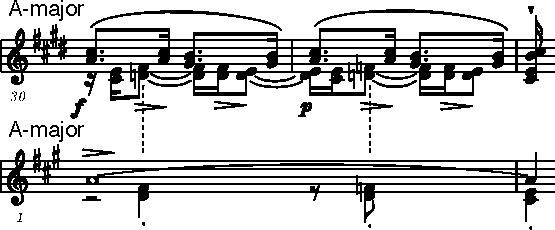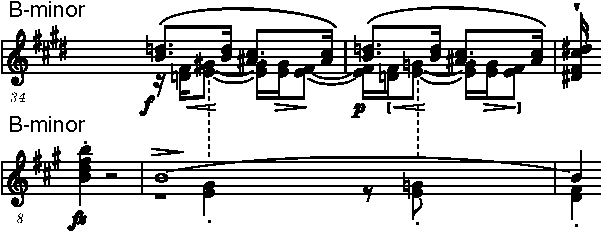



Bars 30-31 and 34-35, creating a progression, may be considered jointly, as bars 32-33 have a transitional character. Their differing in particular sources sound has been raising numerous doubts for a long time. By the end of the 1870s, Chopin's pupil, Karol Mikuli, wrote about "various versions [of these pairs of bars], stemming from various editions and traditions"*. The doubts were increased by the lack of access to the autographs of the Etude. Below we present and characterise all manuscript and printed versions of these bars.
A u t h e n t i c v e r s i o n s
1. The original, completed later by Chopin, version of AI:

We reproduce this version on the basis of the analysis of Chopin corrections visible in AI. The accidentals in brackets are our addition and they constitute the most plausible addition of the unfinished notation of AI. In this version each pair is made of two identical bars, maintained diatonically in the A major and B minor keys.
2. The final version of AI, created by adding chromatically changed thirds of the bottom voice in bars 31 and 35 and a  before g
before g 1 in bar 34. Chopin wrote up this version in A, adding dynamic indications and accents; it is in this finished form that it was printed in FE1 (→EE2):
1 in bar 34. Chopin wrote up this version in A, adding dynamic indications and accents; it is in this finished form that it was printed in FE1 (→EE2):

Lack of the  lowering d
lowering d 1 to d1 on the 2nd semiquaver is striking. This patent Chopin's oversight (in the manuscripts and first editions of his works we can find hundreds of similar inaccuracies) became one of the main reasons for development and diffusion of non-authentic versions of the discussed fragment (versions 5 and 6).
1 to d1 on the 2nd semiquaver is striking. This patent Chopin's oversight (in the manuscripts and first editions of his works we can find hundreds of similar inaccuracies) became one of the main reasons for development and diffusion of non-authentic versions of the discussed fragment (versions 5 and 6).
The version was also included in the lost pupils' copy of GE belonging to Chopin's pupil, Friderike Müller-Streicher, hereinafter marked with the [GES] symbol, in which Chopin added a  instead of the printed there
instead of the printed there  , before the upper note of the third at the beginning of bar 34, changing d
, before the upper note of the third at the beginning of bar 34, changing d 2 to d2 (see version 5 below). The information about the entry contained therein was given by Mikuli in the aforementioned letter to Hiller**.
2 to d2 (see version 5 below). The information about the entry contained therein was given by Mikuli in the aforementioned letter to Hiller**.
The authenticity of this 2nd version was additionally confirmed by Hiller in that letter, who to the version of GE written by Mikuli – with d 2 and d
2 and d 1 in bar 34 – added naturals before these notes.
1 in bar 34 – added naturals before these notes.
V e r s i o n s o f u n c e r t a i n a u t h e n t i c i t y
3. Version of FE2:

FE2 was corrected by Chopin, yet while adding a  lowering d
lowering d 1 to d1 does not raise any doubts, in the case of change of the
1 to d1 does not raise any doubts, in the case of change of the  of g
of g 1 to a
1 to a  of g1 one cannot exclude a kind of misunderstanding at the time of proofreading (related, e.g., to similarity of bars 34 and 35).
of g1 one cannot exclude a kind of misunderstanding at the time of proofreading (related, e.g., to similarity of bars 34 and 35).
4. The version of FED, in which naturals at the beginning of bar 31 were added in pencil to the version of FE2:

The version is encumbered by the uncertainty of the printed version of FE2 (g1 in bar 34). The entry in bar 31 is probably authentic, yet the lack of a similar change in the remaining pupils' copies (FES, FEJ, [GES]), does not allow for it being considered as binding.
N o n - a u t h e n t i c v e r s i o n s
5. The version of GE, as well as of EE4:

The author of this version is certainly the reviser of GE1, correcting the incomplete text of the base text (FE1). Guided by the conventional harmonic sensitivity, he most probably considered the  before the first third in bar 34 to have been placed one bar too early and he deleted it.
before the first third in bar 34 to have been placed one bar too early and he deleted it.
6. The version appearing most frequently in the subsequent collective editions of the Etudes:

It is a compilation of versions 4 and 5, performed in the 1870s, first in the editions by Klindworth and Mikuli.
It should be underlined that the B major key present in versions 5 and 6 in bar 34 is not included in any of the sources, which Chopin had in hands — AI, A, FE1, FE2, FED, FES, FEJ, [GES].
We choose version 2 as the main text, which is the most certain one, as far as the sources are concerned. It is also the musically richest one:
- the sound layout of each of these four bars is slightly different;
-
in both discussed pairs of bars the harmonic differences coincide with the dynamic contrasts
 –
– ;
; - the mentioned pairs of bars differ in the mode (major-minor), which corresponds to the increased tension related to the ascending progression.
An identical scheme appears at the beginning of Allegro de Concert, Op. 46:


Versions 3 and 4, approved by Chopin during the lessons, can be considered as variants.
* A letter of Mikuli to Ferdinand Hiller, a friend of Chopin, asking to solve the doubts concerning the authentic text of nine places in various Chopin's pieces, among others, bars 30-31 and 34-35 of the discussed Etude (Bibliothek des Landes Konservatoriums, Graz).
** Mikuli writes that "Ms. Friderike Streicher has a copy in which Chopin himself wrote a  in pencil before d [in bar 34], without deleting the
in pencil before d [in bar 34], without deleting the  before g
before g !”
!”
Compare the passage in the sources »
category imprint: Interpretations within context; Differences between sources; Corrections & alterations
issues: Annotations in teaching copies, Annotations in FED
notation: Pitch


